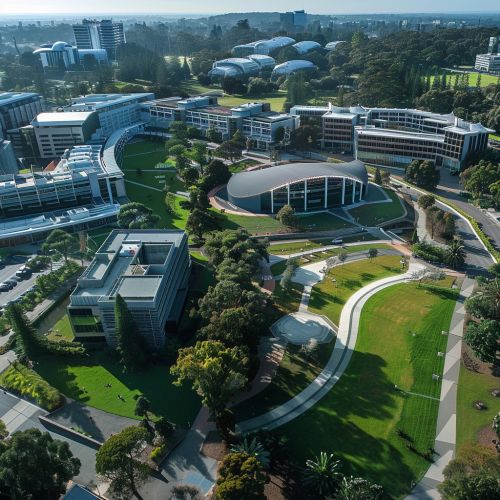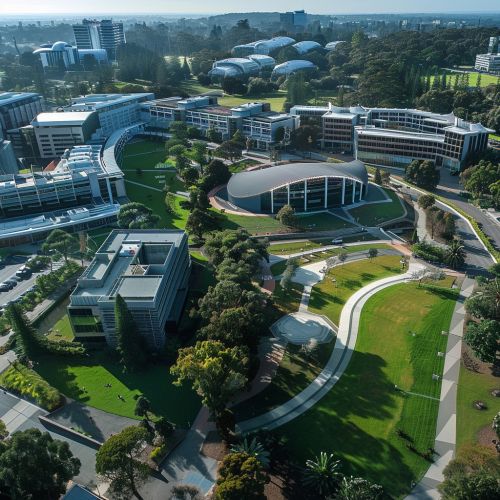Higher Education in Canada: Difference between revisions
(Created page with "== Overview of Higher Education in Canada == Higher education in Canada encompasses a diverse range of institutions, including universities, colleges, and technical schools. The system is characterized by its decentralized nature, with each of Canada's ten provinces and three territories responsible for the administration and regulation of education within their jurisdictions. This article provides an in-depth exploration of the structure, governance, funding, and key f...") |
No edit summary |
||
| Line 69: | Line 69: | ||
Higher education in Canada is a dynamic and evolving sector that plays a crucial role in the country's social and economic development. With a strong commitment to quality, accessibility, and innovation, Canadian higher education institutions continue to prepare students for success in a rapidly changing world. | Higher education in Canada is a dynamic and evolving sector that plays a crucial role in the country's social and economic development. With a strong commitment to quality, accessibility, and innovation, Canadian higher education institutions continue to prepare students for success in a rapidly changing world. | ||
[[Image:Detail-97399.jpg|thumb|center|Aerial view of a university campus with modern buildings and green spaces.|class=only_on_mobile]] | |||
[[Image:Detail-97400.jpg|thumb|center|Aerial view of a university campus with modern buildings and green spaces.|class=only_on_desktop]] | |||
== See Also == | == See Also == | ||
Latest revision as of 14:19, 29 July 2024
Overview of Higher Education in Canada
Higher education in Canada encompasses a diverse range of institutions, including universities, colleges, and technical schools. The system is characterized by its decentralized nature, with each of Canada's ten provinces and three territories responsible for the administration and regulation of education within their jurisdictions. This article provides an in-depth exploration of the structure, governance, funding, and key features of higher education in Canada.
Historical Development
The history of higher education in Canada dates back to the establishment of Université Laval in 1663, the first institution of higher learning in the country. The development of higher education was influenced by the British and French colonial powers, leading to the establishment of institutions that reflected the linguistic and cultural diversity of the nation. The 19th and 20th centuries saw significant expansion, with the creation of numerous universities and colleges across the country.
Structure and Governance
Universities
Canadian universities are primarily publicly funded and offer a wide range of undergraduate, graduate, and professional programs. They are autonomous institutions governed by boards of governors and senates. The Association of Universities and Colleges of Canada (AUCC), now known as Universities Canada, plays a key role in representing universities at the national level.
Colleges and Institutes
Colleges in Canada, also known as community colleges or technical institutes, provide vocational education and training, as well as diploma and certificate programs. They are governed by provincial legislation and often have strong ties to local industries and communities.
Private Institutions
While the majority of higher education institutions in Canada are public, there are also private universities and colleges. These institutions are typically smaller and may offer specialized programs not available at public institutions.
Funding and Financial Aid
Higher education in Canada is funded through a combination of government grants, tuition fees, and private sources. The federal government provides funding primarily through research grants and student financial aid programs, while provincial governments are responsible for the majority of operational funding.
Tuition Fees
Tuition fees vary widely across provinces and programs. Generally, fees are higher for international students compared to domestic students. Financial aid, including scholarships, grants, and loans, is available to help offset the cost of tuition.
Research Funding
Research funding in Canada is provided by federal agencies such as the Natural Sciences and Engineering Research Council (NSERC), the Social Sciences and Humanities Research Council (SSHRC), and the Canadian Institutes of Health Research (CIHR). These agencies support research across a wide range of disciplines and promote innovation and knowledge transfer.
Academic Programs and Degrees
Canadian higher education institutions offer a variety of academic programs leading to degrees, diplomas, and certificates. The degree structure is similar to that of the United States, with bachelor's, master's, and doctoral degrees.
Undergraduate Programs
Undergraduate programs typically lead to a bachelor's degree and require three to four years of full-time study. Programs are offered in a wide range of disciplines, including arts, sciences, engineering, and business.
Graduate Programs
Graduate programs include master's and doctoral degrees. Master's programs usually require one to two years of study, while doctoral programs can take four to six years to complete. Graduate education emphasizes research and advanced study in specialized fields.
Professional Programs
Professional programs, such as medicine, law, and education, are offered at both the undergraduate and graduate levels. These programs prepare students for specific careers and often include practical training components.
Quality Assurance and Accreditation
Quality assurance in Canadian higher education is maintained through a combination of internal and external processes. Institutions undergo regular reviews and assessments to ensure that they meet established standards of quality and effectiveness.
Provincial Quality Assurance Agencies
Each province has its own quality assurance agency responsible for overseeing the quality of higher education institutions and programs. These agencies conduct evaluations and accredit programs to ensure they meet provincial standards.
National and International Accreditation
In addition to provincial quality assurance, some programs and institutions seek accreditation from national and international bodies. This can enhance the reputation of the institution and provide assurance of quality to students and employers.
Challenges and Trends
Accessibility and Affordability
One of the key challenges facing higher education in Canada is ensuring accessibility and affordability for all students. Rising tuition fees and the cost of living can create barriers for some students, particularly those from low-income backgrounds.
Internationalization
Canadian higher education institutions are increasingly focused on internationalization, attracting students from around the world and promoting global partnerships. This trend enhances the diversity of the student body and fosters cross-cultural understanding.
Technological Advancements
The integration of technology in higher education is transforming teaching and learning. Online and blended learning models are becoming more prevalent, providing greater flexibility and access to education.
Indigenous Education
There is a growing emphasis on improving educational outcomes for Indigenous students and incorporating Indigenous knowledge and perspectives into the curriculum. This is part of a broader effort to address historical injustices and promote reconciliation.
Conclusion
Higher education in Canada is a dynamic and evolving sector that plays a crucial role in the country's social and economic development. With a strong commitment to quality, accessibility, and innovation, Canadian higher education institutions continue to prepare students for success in a rapidly changing world.


